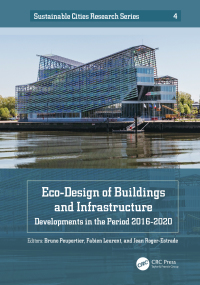Buy Eco-Design of Buildings and Infrastructure: Developments in the Period 2016-2020 1st Edition PDF ebook by author Bruno Peuportier; Fabien Leurent; Jean RogerEstrade – published by CRC Press in 2021 and save up to 80% compared to the print version of this textbook. With PDF version of this textbook, not only save you money, you can also highlight, add text, underline add post-it notes, bookmarks to pages, instantly search for the major terms or chapter titles, etc.
You can search our site for other versions of the Eco-Design of Buildings and Infrastructure: Developments in the Period 2016-2020 1st Edition PDF ebook. You can also search for others PDF ebooks from publisher CRC Press, as well as from your favorite authors. We have thousands of online textbooks and course materials (mostly in PDF) that you can download immediately after purchase.
Note: e-textBooks do not come with access codes, CDs/DVDs, workbooks, and other supplemental items.
eBook Details:
Full title: Eco-Design of Buildings and Infrastructure: Developments in the Period 2016-2020 1st Edition
Edition: 1st
Copyright year: 2021
Publisher: CRC Press
Author: Bruno Peuportier; Fabien Leurent; Jean RogerEstrade
ISBN: 9780367557706, 9781000260847
Format: PDF
Description of Eco-Design of Buildings and Infrastructure: Developments in the Period 2016-2020 1st Edition:
The Chair Eco-design of buildings and infrastructure, a partnership between three engineering colleges (MINES ParisTech, Ecole des Ponts ParisTech and AgroParisTech) and the VINCI group, aims to create measurement and simulation tools which integrate all the dimensions of eco-design (greenhouse gas emissions, impact on biodiversity and resource levies, etc.) to become real decision-making tools, based on a scientific approach, for all actors in the city (designers, builders and users). This book reviews the second five-year sequence of the Chair, first presenting methodological advances in eco-design: life cycle assessment and quantification of uncertainties; local environmental impacts of transport and biodiversity. The interdisciplinary partnership, also associating the human sciences, shows its interest in taking into account the human factor in the modelling of urban systems. This modelling is based on several numerical simulation tools, presented in the third part. This theoretical set results in more substantial proposals for the renewal of techniques and systems, in terms of energy management strategies in buildings, urban agriculture, participatory data collection and digital transformation in transport. This book is intended for urban planners, local authorities, building owners, architects, design offices, companies, building managers, teacher-researchers and anyone interested in the environmental quality of our living spaces.





